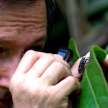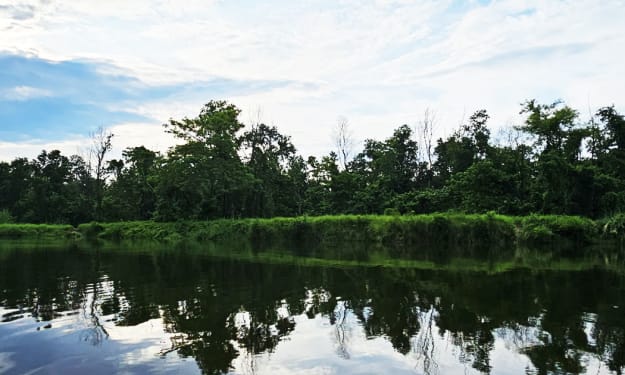A Passion for Nature, Art, and Sharing
A Year Of Weirdness

My life is filled with passions. The urge to share what I discover in my travels and wild adventures through tropical rainforests, Mediterranean landscapes, arid deserts with subtle but diverse life, and waters that flow through ancient channels filled with life largely unknown. I feel driven to improve my photography and illustration skills to tell better the stories that move me. My desire to please others with my music and art, inspired by romantic tendencies from my adolescent years that I have never been able to outgrow. Growing frustration with the pervasive thought that I’m running out of time to do all that I want to do.
This urge to share had brought me to excesses. A few years back, I wrote a daily blog, with photos and videos, in Spanish and English, about the extraordinary creatures that thrive out of sight from the bulk of society, unnamed many of them, habits unknown, secrets unrevealed. I wrote 365 essays in one year. It nearly killed me, getting up at 4 am every morning to write, to edit, to select and improve the photos and illustrations; to translate, and to publish, all before breakfast, while living in a cabin deep in the rainforest. I was working full-time running a research center—an insane schedule, hectic and impossible. But one of the most satisfying things I’ve done in my life. The Daily Dose of Weirdness became a challenge, a self-imposed dare to achieve something. Important? I don’t know. In terms of its scientific value, perhaps not so much. Educational value? More than maybe I can measure. The following of the blog? Very selective, a few colleagues and friends and a few others had heard about it and checked it out. I can assemble it as a book, perhaps, and sell a hundred copies, who knows. The hunger to learn about tropical bugs, snakes, and weird plants and animals with bizarre habits and behaviors doesn’t look like ingredients for a best seller. But the project was fueled by a passion for nature, for strange, vilified, and misunderstood creatures, and by a life-long love for wildlife and the science that helps us understand it.
Here is one encounter that left a deep mark and impression in me some years ago, while living embedded in the chaotic wild richness of a Central American rainforest.
It was one of those days where I took time from the busy schedule of meetings and administration of the La Selva Research Station to immerse myself for a couple of hours in the extraordinary setting of the wet and quiet rainforest. I walked down a trail deeper and deeper into the forest, sunlight filtering through the dense canopy creating a kaleidoscope of light spots and shadows. I knew this rainforest well, having worked as a researcher there for over half a decade. This tangled jungle never stopped surprising me. I had walked this trail probably a thousand times since I first arrived at the research station, and every time, without exception, I saw something I had never seen before. An insect, a plant, an interaction between an animal and its prey or host plant. The stories had been endless, and the fascination ever-growing. After an hour walk, I stepped off the muddy trail a few dozen steps, following a hunch. I had seen a patch of Heliconia plants a few days before, their broad leaves looking like small versions of banana leaves. One of the leaves on one plant was collapsed, its central vein damaged by a creature that every visitor to the rainforest longs to see. This particular day, I approached the plant silently, slowly so as not to disturb the treasure hidden by the folded leaf.
There was no movement within, and not even a gentle breeze stirred the leaves. The heat was palpable, and my sweat sat there, soaking my clothes and sticking to my skin, moisture that would not evaporate in the 100% humidity calm air. I kneeled near the base of the plant and took a peek under the folded leaf. I saw small movements. They were there, slightly disturbed by my sudden appearance in their field of view. I could actually see their silhouette through the leaves when the subdued rays of sunlight hit the leaves. I retreated a couple of steps to prepare my approach. I laid on my back on the wet leaf litter, camera in hand, and slowly scooted forward, inches at a time, until my head was right under the leaf tent. I looked through my camera’s viewfinder and saw the creatures, a cluster of Ecuadorian white bats, Ectophylla alba, resting under their leaf tent that they made themselves, waiting for nighttime to fly off into the forest to forage for ripe fruit.
They were tiny, smaller than a golf ball when cuddled with each other; five of them, tightly clustered. One was smaller and grayish, a juvenile, probably still nursing, snuggled closely against the body of its mother. Under the natural light filtered through the leaf surface, they looked like green bumps on the plant, their fluffy white coats reflecting the filtered light in a stunning camouflage display. With the aid of a small light, I snapped a couple of photos, and their whiteness became evident. I retreated slowly from under their shelter, careful not to disturb them, exhilarated by the moment. I looked forward to studying the images on my computer showing the exquisite detail of their anatomy. One of the 70 species of bats that live in this rainforest, the white bats still hold a special place in my heart. They feed on wild figs and other small fruits, spreading their seeds through the forest. Their life history is as extraordinary as their looks, giving me many hours of research, reading, and learning about how they connect to the cacophony of life in this endangered ecosystem.
So now, there it sits, one of 365 short essays fully illustrated, showcasing some of the strangest creatures, some astonishingly beautiful, others shy and secretive but extraordinary. It was an entire year of secrets and stories, high in wow-factor, waiting to be born again from an exhausted but inexplicably persistent mind. Creatures looking for eyes and ears to tell their stories, seeking a receptive audience that shares the same hunger for knowledge, appreciation for nature, and a desire, a passion for doing something about it, may help save them from extinction.
A year of stories could turn into more years of stories because the sources are practically inexhaustible, their fragility hard to comprehend and because time is of the essence.
Carlos L. de la Rosa






Comments
There are no comments for this story
Be the first to respond and start the conversation.